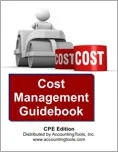Cost Management Guidebook (CPE Course)
CPE Credit: 17 hours
Course Type: Downloaded PDF materials with online test
Price (with PDF Textbook): $120
Course Description
The Cost Management Guidebook shows how to stay competitive by paring away nonessential costs. It discusses how to examine the cost structure of a business in order to better understand which costs must be incurred and which can be reduced. Hundreds of specific cost reduction tips are covered in all areas of a business, including compensation, sales, production, procurement, and administration. There are extensive discussions of asset reduction techniques, as well as cost management reports and measurements. This course is the essential toolkit for anyone who is serious about managing costs.
Author: Steven Bragg
Course Number: FN1004
Table of Contents
Chapter 1. Overview of Cost Management
Chapter 2. Types of Costs
Chapter 3. Direct Costing as an Analysis Tool
Chapter 4. Cost-Volume-Profit Analysis
Chapter 5. Target Costing
Chapter 6. Cost Object Analysis
Chapter 7. Constraint Analysis
Chapter 8. Process Analysis
Chapter 9. Zero Base Budgeting
Chapter 10. Cost Reduction Strategy
Chapter 11. Compensation Cost Reduction
Chapter 12. Benefits Cost Reduction
Chapter 13. Sales and Marketing Effectiveness
Chapter 14. Production and Maintenance Cost Reduction
Chapter 15. Procurement Cost Reduction
Chapter 16. Administration Cost Reduction
Chapter 17. Facilities Cost Reduction
Chapter 18. Finance Cost Reduction
Chapter 19. Accounts Receivable Reduction
Chapter 20. Inventory Reduction
Chapter 21. Capital Budgeting Decisions
Chapter 22. Cost Management Reports
Chapter 23. Cost Management Measurements
Learning Objectives
Specify the advantages and dangers of having an active cost management program.
Identify the various types of costs, and how they are used.
Cite the applications to which direct costing analysis can be put, as well as any limiting factors.
State the components and derivation of the cost-volume-profit concept, and how it is used.
Identify the uses to which target costing can be put, as well as how costs can be altered to meet target costing goals.
Specify the costs that are associated with cost objects, and the decisions that can arise from cost object analysis.
Identify the key components of constraint analysis, and how profits can be improved under this type of analysis.
Cite the tools used to conduct a process analysis.
State the components of a zero-base budgeting system, and the situations in which zero-base and conditional budgeting can be used.
Specify the analysis tools to use for different cost reduction strategies.
Cite the types of cost reduction methods available when reducing compensation costs, and the side effects of using these methods.
State the methods used to reduce benefit costs, and the side effects of using these methods.
Identify the techniques available for increasing the effectiveness of sales and marketing activities, and the side effects of using these methods.
Identify the cost reduction techniques that can be used to reduce the costs of production and maintenance operations, and the side effects of using these methods.
Cite the key procedural steps and forms needed to maintain a proper system of procurement.
State the range of methods available for the reduction of costs for accounting, human resources, legal services, and other areas of administration.
Identify the cost reduction tactics available for managing facilities costs.
Specify the methods used to reduce finance costs.
Cite the range of techniques used to reduce the investment in accounts receivable, and the situations in which they are most applicable.
State the cost reduction concepts used to reduce the level of inventory, and the situations in which they are most applicable.
Identify the analysis methods used to evaluate prospective investments in fixed assets, as well as alternative forms of payment for these assets.
Discuss the reasoning behind having a post-implementation review.
Identify the key reports and report formats needed to support a system of cost management, and the situations in which these reports might be used.
Cite the most essential measurements used to evaluate the cost structure of a business, and the situations in which these measurements might be used.
Level: Overview
Instructional Method: QAS Self-Study
NASBA Category: Management Services
Prerequisites: None
Advance Preparation: None
Latest Review Date: September 2023
Program Registration Requirements: Click on "Purchase Course" near the top of this page to pay for and access the course. You will then be able to download the course as a PDF file, then take an on-line examination, and then download a certificate of completion if you pass the examination.
Program Refund Policy: For more information regarding administrative policies concerning complaints, refunds, and other matters, see our policies page.
AccountingTools, Inc. is registered with the National Association of State Boards of Accountancy (NASBA) as a sponsor of continuing professional education on the National Registry of CPE Sponsors. State boards of accountancy have the final authority on the acceptance of individual courses for CPE credit. Complaints regarding registered sponsors may be submitted to the National Registry of CPE Sponsors through its website: www.nasbaregistry.org.
The NASBA sponsor identification number for Accountingtools, Inc. is 115881.
AccountingTools is an IRS Approved Continuing Education Provider. We are compliant with the requirements for continuing education providers (as described in sections 10.6 and 10.9 of the Department of Treasury’s Circular No. 230 and in other IRS guidance, forms, and instructions). Our IRS Approved Continuing Education Provider number is 72821.


